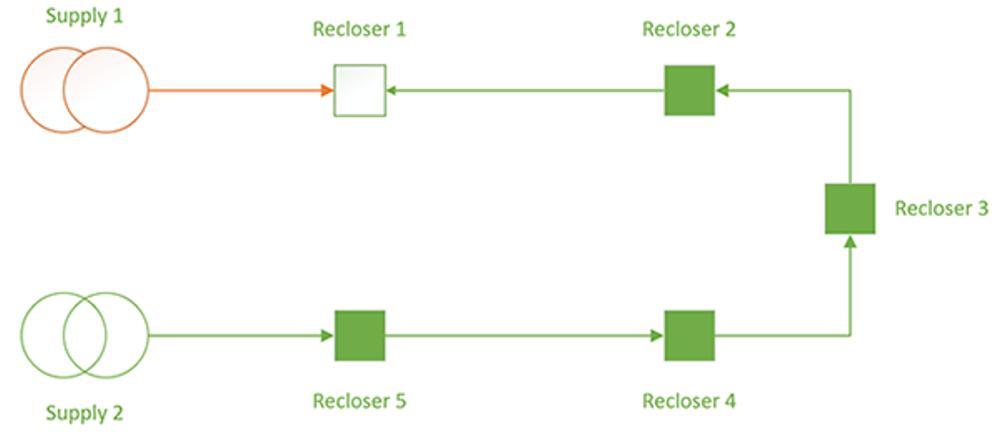Các bài báo kỹ thuật
Đã xuất bản 08/2019
Distributed Automation V – Centralised vs Decentralised Automation
The two paradigms in Smart Grid implementation

Through our series on implementing the Smart Grid, or electricity Distribution System Automation, we have explored various use cases of Reclosers being deployed to automatically reconfigure the network to isolate faults and restore supply. Fundamentally, the usage of voltage sensing on either side of the interrupting device affords great capability in network automation, as the presence/absence of voltage on a circuit breaker can be used as an automation logic input.
Cases which use only voltage sensing for automation schemes are considered communications-free, as no dedicated information sharing is required between devices. These implementations are simple, robust and cost effective, but require an additional close-onto-fault operation. The simple method to resolve the close-onto-fault case is to introduce communications between devices, (which we explored our first case in Distribution Automation II), providing a data link between the reclosers to prevent this close-onto-fault behaviour.
At a higher level however, this form of Smart Grid implementation can be categorised as “Distributed Automation” – that is, automatic re-switching of the network where the logic for the automation is controlled and implemented throughout the grid at the recloser/Intelligent Electronic Device (IED) level.

All cases explored thus far in our series on Smart Grid automation fall into the “Distributed Automation” example. Distributed Automation is generally faster and more reliable than other automation methods, as the decision making is executed closer to the fault sites and there is a limitation in communications propagation delays and calculation delays. It is also the most cost-effective method of distribution automation, but it can become operationally challenging to manage and control, requiring a substantial training overhead to ensure that network operators are familiar with the schemes.
The counter-case to this decentralised model is the “Centralised Automation” scheme, where a utilities central automation server retrieves network parameters from field devices and makes automatic re-switching decisions based on its programming logic.

Centralised automation can be implemented as a plug-in extension to a utilities existing SCADA infrastructure. A SCADA Master Station or Server (depending on your protocol) already has access to all information necessary to automate switching decisions. Centralised automation is essentially the automation of the activities of a utility control room.
Centralised automation necessitates the implementation of reliable communications to the field devices, as any effective SCADA controlled electricity distribution system requires. Implementing Centralised Automation becomes the natural smart grid implementation method for a utility with a centralised SCADA control room, as it brings the advantages of remote control of the schemes and the simplification of automation control itself.
Reclosers remain the backbone of such an automation scheme, as they provide the fault interruption capacity in the field and the data processing capability of network system parameters that can be fed back to the centralised SCADA system or automation controller. Switching commands are then returned from the automation controller to the field reclosers, as the automation system acts as the smart grid orchestral conductor to the field instruments.
Centralised Automation offers benefits in operations management and simplicity of implementation at the cost of slightly slower automation response times, provided that there is a pre-existing communications network and centralised SCADA control system in place. For utilities that have not reached this level of SCADA who are committed to the centralised automation path, Centralised Automation should remain a goal with centralised SCADA control as the first goal to achieve.
The best network performance is reserved for utilities who implement a hybrid of these two automation paradigms. By using Distributed Automation for Auto-Changeover Schemes with a centralised control system, utilities capture the speed and reliability of distributed automation with the management simplicity and control of centralised automation. This is the most common implementation in advanced utilities, combining the benefits and mitigating the risks of both methods by using them simultaneously.
“Centralised automation is somewhat limited by the reliability of the communications network and the latency of the communications network,” says NOJA Power Group Managing Director Neil O’Sullivan. “In modern implementations this is addressed by using IEC61850 GOOSE and MMS messaging which can be utilised as part of the centralised automation systems. It is also important to point out the goose messaging can be used for automation while another protocol for example DNP3 can be used to interface to the central SCADA system with IEC 61850 GOOSE messaging overlaid on the communications network for higher speed automation applications.”
Our next edition in this series will cover the role of PLC Protocols in the distribution network for automation, which has been implemented in the NOJA Power OSM Recloser as “Smart Grid Automation IEC61499”. This versatile feature provides endless customisation to the usage of reclosers, but it’s prudent application to cover niche cases not yet mentioned in our series which makes this capability so powerful.
Quan tâm đến Công nghệ mới nhất về phân phối điện năng?
Hãy tham gia vào danh sách nhận các bài viết kỹ thuật hàng tuần, chúng tôi sẽ chia sẻ kinh nghiệm trong nghành kỹ thuật điện toàn cầu trực tiếp đến hộp thư của bạn
Đăng ký →